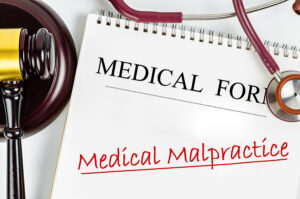Medical malpractice is an error made by a health care provider that results in injury to a patient. When this occurs, the injured patient can seek compensation through the medical malpractice insurance policy held by the at-fault provider. If the insurance company refuses to pay the claim, the patient also has the option to file it as a medical malpractice lawsuit in court. Then a jury will determine if the provider is liable for compensating the patient and, if so, how much compensation is owed.
While television and movies almost always portray legal actions as taking place in a courtroom, the reality is that the vast majority of medical malpractice claims are settled out of court. There are so many settlements in personal injury cases because litigation is expensive, time-consuming, and features an uncertain outcome for the provider and their insurance company. It’s often easier and less costly to enter a settlement agreement with the claimant.
The claimant also faces uncertainty in litigation and odds often stacked in favor of the provider, as it is very difficult to obtain the medical evidence needed to prove a malpractice claim. Claimants and their attorneys are also more likely to agree to a fair settlement if one is offered than to take their chances with litigation.
What Types of Medical Errors Can Result in a Medical Malpractice Claim?

Not all medical errors give rise to a medical malpractice claim, and not all bad outcomes are considered errors. Some risks and complications can occur with any medical treatment, even if provided by the most care providers and in the most pristine conditions. The error must have resulted in an injury to be considered medical malpractice.
Statistics show that 55 percent of U.S. physicians have faced medical malpractice claims. More than half of those doctors have faced more than one malpractice claim during their careers. Those who practice medical specialties such as surgeons, obstetricians, and gynecologists are far more likely to be the defendant in a medical malpractice claim than primary care physicians.
Some of the types of errors that can cause an injury to a patient and lead to a medical malpractice claim include:
- Diagnosis errors, including failure to diagnose, misdiagnosis, or delayed diagnosis can prevent a patient from obtaining the treatment they need when suffering an injury or illness
- Surgical errors that cause damage to the organ being operated on or other nearby organs, as well as mistakes such as wrong-site surgery, wrong-patient surgery, or the accidental leaving of surgical tools, sponges, or towels inside the body cavity.
- Prescription errors, such as giving the patient the wrong dose of medication or the wrong kind of medication to treat their condition
- Failure to inform the patient of the known risks of a procedure if it can be shown that the patient likely would have sought alternative treatment options if they had been given all the information needed to make an informed decision
- Failure to adequately monitor a patient after a procedure, including premature discharge from the hospital, lack of follow-up care, or failure to provide home-care instructions
Why Do Medical Errors Occur?
Individuals in the U.S. place a lot of trust and confidence in those who provide treatment for their medical conditions. This trust and confidence are often earned by the providers who go the extra mile to create positive patient outcomes. Even the best physicians can make errors that result in injuries.
Some of the reasons for medical errors include:
- Lapses in communication and organizational challenges when sharing information between providers or between staff members going off the shift and the workers coming on shift to resume the duties involved in providing patient care.
- Understaffing has been a well-reported issue in recent years, particularly since the advent of COVID-19. According to U.S. News & World Report, the number of workers in the healthcare industry declined by about 176,000 from February 2020 just before the pandemic began. These workers don’t just include doctors but also nurses, medical lab workers, and even paramedics. Having fewer workers does not equate to having less work, however. Instead, it leaves those remaining in the industry with more work than they can safely or comfortably do, making mistakes in the provision of health care far more likely.
- Lack of adequate training or experience in the procedure being performed. Because of the health care staff shortage, individuals entering the industry’s workforce have less time to obtain the training and knowledge of the facility’s policies and procedures that have been put in place to prevent patient injuries.
- Technical issues, such as improper interpretation of lab results or defects in the tools used to perform surgery on the patient
The Complexities of Medical Malpractice Cases
Between 210,000 to 440,000 deaths in the U.S., each year result from medical errors, making it one of the leading causes of death in the nation as well as a common cause of injury.
However, obtaining compensation in many of those cases is extremely difficult due to several issues inherent in medical malpractice claims, including:
- Lack of reporting of the error to the patient. In other types of accidents that result in a personal injury claim, such as a car accident, it will be immediately obvious that an error resulted in injury. Law enforcement will investigate the cause of the accident to determine if the accident was the result of someone’s illegal actions. However, it is not always immediately obvious that an injury has occurred in the medical arena. Studies show that 67 percent of patients who incur an injury due to a medical error are not informed by their doctors that an error occurred. If the error was not included in the doctor’s notes, it could be difficult to obtain the evidence to prove in court that it took place. It is even harder to prove who was responsible for the error.
- Often, patients whose physician has not told them that an error has occurred must report this error themselves or have someone report it on their behalf. Around 56 percent of patients who failed to report a medical error that resulted in injury declined to do so because they didn’t believe it would do any good. Around 10 percent declined to report the error because they didn’t know the proper procedure in which to do so.
- Lack of understanding about the time limits of filing a medical malpractice claim. Each state in the nation has a statute of limitations that governs the amount of time an injured party must file a legal claim to seek compensation for their injuries. Because of the unique features of a medical malpractice claim including the notion that the claimant did not necessarily know right away that an error had taken place these time limits can vary. For example, in Illinois, personal injury claimants in most types of cases have at least two years to file a personal injury lawsuit. This statute of limitations applies to many medical malpractice claims. Claimants are granted up to four years after the date of injury to seek compensation for injuries they were not immediately aware of. If the injury involves a minor, the statute of limitations can be eight years from the date of the injury or within two years of the child reaching the age of majority (18). The difference in time depends on whether the child’s parents are seeking compensation on the child’s behalf or an adult is making a claim for compensation for injuries they incurred as a child.
- Increased requirements for filing a medical malpractice lawsuit. Many states including Illinois require an affidavit of merit to be filed along with the lawsuit. This affidavit testifies that the claimant’s attorney has consulted with an experienced and knowledgeable medical professional about the claim and that the professional found after reviewing the details of the incident that there is sufficient merit to the claim to warrant a lawsuit.
The Lawsuit Presents Complex Issues for the Provider, Too
Medical malpractice claims aren’t only difficult for the patient and the provider. Fifty-eight percent of medical providers who participated in a survey conducted by Medscape reported being surprised to find out that they had been named in a medical malpractice claim. Most physicians who sued for medical malpractice felt that the claim was unwarranted.
Some of the issues that made providers more likely to settle a medical malpractice claim out of court include:
- Publicity of the trial by the news media can harm the provider’s reputation. Not only can pre-trial publicity cause the provider to be portrayed in a less than flattering light, but if they lose the case, there are likely to be serious questions and doubts about their ability to provide effective care.
- Increases the premiums that providers pay for their medical malpractice insurance.
- The time-consuming aspect of litigation will draw the physician and other staff members who witnessed the error away from their tasks during an era in which health care facilities can little afford to provide replacement staff while those involved in the lawsuit are attending to the legal process.
How to Ensure the Most Compensation Available for Your Medical Malpractice Settlement
As noted, there are plenty of reasons why settlements are commonly the resolution of choice for medical malpractice claims.
Those who are seeking compensation for injuries that were caused by medical malpractice can do several things to increase their chances of obtaining a fair settlement for their claim, such as:
- Hiring an experienced medical malpractice attorney to assist them as they navigate the personal injury claims process. The attorney can provide services to help the claimant avoid some of the most common issues that negatively impact a medical malpractice claim. These issues include managing the timeline of the case to ensure that a lawsuit is filed within the statute of limitations, establishing a value to the claim that adequately compensates the claimant for the injury they incurred, understanding the type of evidence that is needed to prove the claim, and understanding how to negotiate with a medical malpractice insurer to avoid making mistakes that will result in the reduction or denial of the claim.
- Receiving the information necessary to understand how the case was valued, and what constitutes a fair settlement offer. It is important to know that all major decisions in the claim including the decision on whether to accept a settlement remain the client’s to make. A medical malpractice lawyer’s many important tasks are ensuring their client has the guidance they need to navigate the process and obtain a positive outcome for their claim.
- Carefully document all reports about the injury, as well as the names of any witnesses who were present when the error occurred.
- Exercising patience during the settlement process. Medical malpractice settlements often take up to 2-3 years to resolve by settlement. A settlement agreement can be made any time a claim is made until a trial has occurred. However, the court has not yet rendered a decision. This is a lot of time in which the claimant can grow impatient with the process and decide to accept whatever offer comes their way, even if that offer does not fully compensate them for their injury. It is important to remember, however, that settlements are final. Once an agreement is in place, the claimant waives their right to return and seek more money from the insurer if they later discover that the settlement was insufficient.
Contact the Chicago Medical Malpractice Law Firm of Zayed Law Offices Personal Injury Attorneys for Help Today
For more information, please contact the experienced Chicago medical malpractice lawyers at Zayed Law Offices Personal Injury Attorneys today. We offer free consultations.
We proudly serve Cook County, Will County, Kendall County, and its surrounding areas:
Zayed Law Offices Personal Injury Attorneys – Chicago Office
10 S La Salle St STE 1230, Chicago, IL 60603
Phone:(312) 726-1616
Hours: Open 24/7
Our firm is located near you. We have an office in Chicago
Find us with our GeoCoordinates: 41.8815493,-87.6327515
Zayed Law Offices Personal Injury Attorneys – Joliet Office
195 Springfield Ave, Joliet, IL 60435
Phone: (815) 726-1616
Our firm is located near you. We have an office in Joliet
Find us with our GeoCoordinates: 41.5254295,-88.1381011








